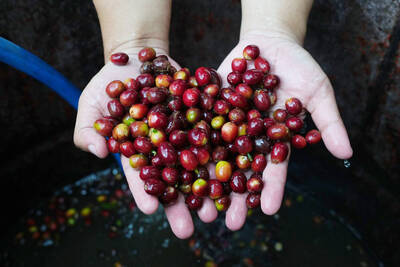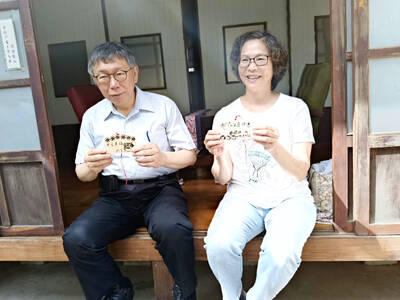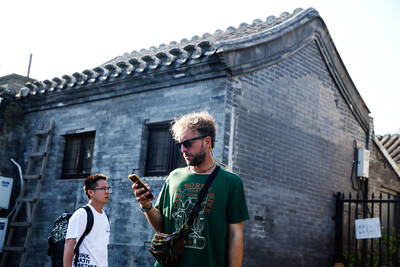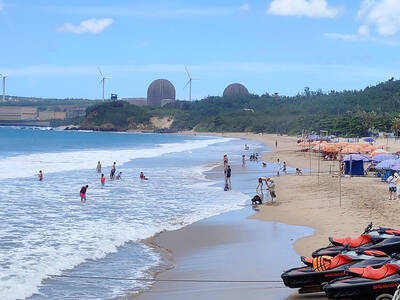From retaliatory tariffs on US goods like car parts and soy beans to controls on raw minerals essential for American manufacturing — analysts say China has plenty of options if it wants to reply to fresh US levies.
US President Donald Trump over the weekend announced 10 percent tariffs on Chinese products, upping the stakes in a trade confrontation between the global superpowers that started eight years ago in his first term.
Beijing in response warned there were “no winners” in a trade war and vowed as yet unspecified countermeasures.

Photo: EPA-EFE
News that Canada and Mexico had agreed a deal with Trump to delay 25 percent tariffs on their goods was followed by his announcement that he would be holding talks with China “probably in the next 24 hours” to try for an agreement.
But, as the threat of new measures continues to hang over Beijing, eyes are on what officials there have lined up as a response. With its economy still struggling with sluggish consumption and slow growth, observers expect China to keep its powder dry for now — at least until another round of tariffs that could do greater damage.
“We expect China not to jump to immediate retaliation following the 10 percent tariff hike, but will keep the doors of negotiation and cooperation open,” UBS bank analysts wrote in a note.
“We do not expect China to follow the same strategy as in the first round of tariff hikes in 2018-19.”
Bilateral trade totaled more than US$530 billion last year, according to US data, with exports of Chinese goods to the United States exceeding US$400 billion. That was second only to Mexico.
But that yawning trade imbalance — US$270.4 billion in January-November last year — has long raised hackles in Washington.
LESSON LEARNED?
Key US demands in the first trade war were greater access to China’s markets, broad reform of a business playing field that heavily favors Chinese firms, and a loosening of heavy state controls.
This time around Washington has also called for China to crack down on exports to Mexico of chemical components used to make the synthetic opioid fentanyl, responsible for tens of thousands of overdose deaths a year. After long, fraught negotiations during Trump’s first term the two agreed what became known as the “phase one” deal — a ceasefire in the nearly two-year-old trade war.
Beijing was quick to retaliate throughout that standoff — imposing tariffs of its own on everything from cars to soybeans, designed to inflict harm on Trump’s voting base in rural America.
It also floated restrictions on exports of rare earth metals, of which China dominates global supplies and on which the United States remains heavily dependent.
And should a new trade war escalate, “measures could include tariffs, export controls on critical minerals essential for US manufacturing, restricted market access to US firms operating in China, or the depreciation of the yuan,” said Harry Murphy Cruise, head of China and Australia economics at Moody’s Analytics.
But he added Beijing may have learned its lesson from the first standoff.
“The tit-for-tat trade war in Trump’s first term benefited no one; it made trade more costly and hindered growth in both countries,” Murphy Cruise said.
CHINA’S WEAKER POSITION
For now, analysts believe the latest measures won’t bite too hard.
“The 10 percent tariff is not a big shock to China’s economy,” Zhang Zhiwei at Pinpoint Asset Management said in a note.
“It’s unlikely to change the market expectation on China’s macro outlook this year, which already factored in higher tariffs from the US,” he added.
And that could allow China to keep its powder dry in the event Trump’s first wave of tariffs are the prelude to a bigger showdown.
The US president has ordered an in-depth review of Chinese trade practices, the results of which are due by April 1.
That could serve as a “catalyst for more tariffs,” said Murphy Cruise, pushing Beijing to shift tactics.
“This strategy of no retaliation may change if the US imposes additional significant tariffs later on,” UBS economists said.
“In such a case, we think China may retaliate on a targeted basis and in a restrained manner, imposing tariffs on selected agricultural products, auto parts, energy,” they said.
Experts added that China could also let the value of its currency devalue, increasing the competitiveness of its exports.
Trump’s flagged talks with Beijing offer the two sides a chance to step back from the brink of a trade war that could hit hundreds of billions’ worth of goods.
“China is looking to diffuse tensions,” Murphy Cruise said.
“China’s economy is in a much weaker position this time around; it will be substantially harder to withstand a barrage of tariffs.”

Climate change, political headwinds and diverging market dynamics around the world have pushed coffee prices to fresh records, jacking up the cost of your everyday brew or a barista’s signature macchiato. While the current hot streak may calm down in the coming months, experts and industry insiders expect volatility will remain the watchword, giving little visibility for producers — two-thirds of whom farm parcels of less than one hectare. METEORIC RISE The price of arabica beans listed in New York surged by 90 percent last year, smashing on Dec. 10 a record dating from 1977 — US$3.48 per pound. Robusta prices have

The resignation of Taiwan People’s Party (TPP) co-founder Ko Wen-je (柯文哲) as party chair on Jan. 1 has led to an interesting battle between two leading party figures, Huang Kuo-chang (黃國昌) and Tsai Pi-ru (蔡壁如). For years the party has been a one-man show, but with Ko being held incommunicado while on trial for corruption, the new chair’s leadership could be make or break for the young party. Not only are the two very different in style, their backgrounds are very different. Tsai is a co-founder of the TPP and has been with Ko from the very beginning. Huang has

A few years ago, getting a visa to visit China was a “ball ache,” says Kate Murray. The Australian was going for a four-day trade show, but the visa required a formal invitation from the organizers and what felt like “a thousand forms.” “They wanted so many details about your life and personal life,” she tells the Guardian. “The paperwork was bonkers.” But were she to go back again now, Murray could just jump on the plane. Australians are among citizens of almost 40 countries for which China now waives visas for business, tourism or family visits for up to four weeks. It’s

A dozen excited 10-year-olds are bouncing in their chairs. The small classroom’s walls are lined with racks of wetsuits and water equipment, and decorated with posters of turtles. But the students’ eyes are trained on their teacher, Tseng Ching-ming, describing the currents and sea conditions at nearby Banana Bay, where they’ll soon be going. “Today you have one mission: to take off your equipment and float in the water,” he says. Some of the kids grin, nervously. They don’t know it, but the students from Kenting-Eluan elementary school on Taiwan’s southernmost point, are rare among their peers and predecessors. Despite most of